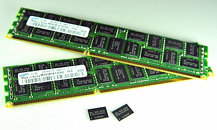- Joined
- Oct 9, 2007
- Messages
- 47,243 (7.55/day)
- Location
- Hyderabad, India
| System Name | RBMK-1000 |
|---|---|
| Processor | AMD Ryzen 7 5700G |
| Motherboard | ASUS ROG Strix B450-E Gaming |
| Cooling | DeepCool Gammax L240 V2 |
| Memory | 2x 8GB G.Skill Sniper X |
| Video Card(s) | Palit GeForce RTX 2080 SUPER GameRock |
| Storage | Western Digital Black NVMe 512GB |
| Display(s) | BenQ 1440p 60 Hz 27-inch |
| Case | Corsair Carbide 100R |
| Audio Device(s) | ASUS SupremeFX S1220A |
| Power Supply | Cooler Master MWE Gold 650W |
| Mouse | ASUS ROG Strix Impact |
| Keyboard | Gamdias Hermes E2 |
| Software | Windows 11 Pro |
Samsung Electronics Co., Ltd., the world leader in advanced memory technology, announced today that it has begun mass producing the industry's first two gigabit (Gb) DDR3 devices using 40 nanometer (nm) class process technology.
"We see market adoption to DDR3 picking up steam and are accommodating that with early entry of 2Gb DDR3 using the most efficient DRAM manufacturing technology available today," said Jim Elliott, Vice President, Memory Marketing, Samsung Semiconductor, Inc. "This will set the pace for a new standard in premium, eco-friendly DRAM solutions offering the most advanced, low power RDIMM for servers anywhere."

Samsung's seven-month window between new process technology development and mass production of the new DDR3 (Jan. to Jul. '09) will allow OEMs to optimize their next-generation systems more quickly.
In addition, moving to a 40nm production process will provide around a 60 percent increase in production productivity over use of a 50 nm process.
Besides 16GB, 8GB and 4GB RDIMMs for servers, Samsung will produce UDIMMs (unregistered in-line memory modules) for work stations and desktop PCs or SODIMMs (small outline dual in-line memory modules) for notebook PCs of up to 4GBs, using the new chip.
The monolithic 2Gb chips are energy-efficient solutions for high-density, high-performance memory applications. Each supports a data rate of up to 1.6 gigabits per second (Gbps) at 1.35 volts, up to twice as fast as an 800Mbps 1Gb-based dual-die package.
According to market research firm iSuppli, 2 Gb DDR3 is expected to account for 82 percent of the total DDR3 DRAM market in units sold by 2012, and become the mainstream DDR3 DRAM product by 2010.
View at TechPowerUp Main Site
"We see market adoption to DDR3 picking up steam and are accommodating that with early entry of 2Gb DDR3 using the most efficient DRAM manufacturing technology available today," said Jim Elliott, Vice President, Memory Marketing, Samsung Semiconductor, Inc. "This will set the pace for a new standard in premium, eco-friendly DRAM solutions offering the most advanced, low power RDIMM for servers anywhere."

Samsung's seven-month window between new process technology development and mass production of the new DDR3 (Jan. to Jul. '09) will allow OEMs to optimize their next-generation systems more quickly.
In addition, moving to a 40nm production process will provide around a 60 percent increase in production productivity over use of a 50 nm process.
Besides 16GB, 8GB and 4GB RDIMMs for servers, Samsung will produce UDIMMs (unregistered in-line memory modules) for work stations and desktop PCs or SODIMMs (small outline dual in-line memory modules) for notebook PCs of up to 4GBs, using the new chip.
The monolithic 2Gb chips are energy-efficient solutions for high-density, high-performance memory applications. Each supports a data rate of up to 1.6 gigabits per second (Gbps) at 1.35 volts, up to twice as fast as an 800Mbps 1Gb-based dual-die package.
According to market research firm iSuppli, 2 Gb DDR3 is expected to account for 82 percent of the total DDR3 DRAM market in units sold by 2012, and become the mainstream DDR3 DRAM product by 2010.
View at TechPowerUp Main Site


 wtf
wtf




 sure its smaller so its cooler (O.C). but what about defualt times. (and horah for lower cost!
sure its smaller so its cooler (O.C). but what about defualt times. (and horah for lower cost!  )
)

